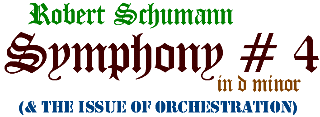 |
|
Robert Schumann's Symphony # 4 in d minor, Op. 120 demands particular attention by illuminating critical debate over the composer's alleged shortcoming as an orchestrator. In this article, we review Schumann's career leading to the first version of the symphony, the emergence of theories of orchestration, Schumann's revision of the symphony, the primary interpretive approaches by which conductors have defended or compensated for the composer's perceived errors in orchestrating his work, and then survey some of the most interesting proactive recordings. Finally, we suggest some sources for further information.
|
|
Robert Schumann (1810 – 1856) was one of the most significant musicians of his time, and indeed in the entire history of Western music.  He was a hugely influential critic, a prescient champion of Chopin and discoverer of Brahms, the originator of long-form piano fantasies, and in retrospect is viewed as the apex of Romanticism. He was a hugely influential critic, a prescient champion of Chopin and discoverer of Brahms, the originator of long-form piano fantasies, and in retrospect is viewed as the apex of Romanticism.
Yet despite this remarkable legacy, a huge dark cloud hangs over his reputation – Schumann is often cited as the worst orchestrator among major composers. Thus, Adam Carse in his 1925 History of Orchestration asserts: "Schumann was unable to handle the orchestra even moderately well; his music survives in spite of its orchestration." Conductor Theodore Thomas, who founded the Chicago Symphony, was quoted in a 1922 New York Times article thus: "Such fine, noble themes, good workmanship, and yet such abominably bad orchestration." Conductor Felix Weingartner contended in his 1904 The Symphony Since Beethoven that Schumann's "sound is thick and clumsy, the color gray on gray; the most important voices … sometimes cannot … be heard." Yet this toxic censure is barely merited. Indeed, more modern critics are willing to credit Schumann's orchestration as individual expression, consistent with the other elements of his music, rather than failing to conform to the rigid expectations of prior times.
 Schumann's life, both professional and personal, followed a Romantic trajectory, from ardent beginning to tragic conclusion. He fell deeply in love with the daughter of his piano teacher when she was a child prodigy of nine, ultimately married her after a lengthy, bitter fight with her father, who filed lawsuits with reckless accusations to prevent it, saw her career eclipse his, and after mounting depression and suicide attempts placed himself in an asylum where he deteriorated for two years and died alone at age 46 (possibly from syphilis – the final diagnosis was "gradual inexorable deterioration of the structure and functions of the entire nervous system"). In between lay two decades of composition, to which he turned after abandoning a concert career, the sad and ironic result of permanently having injured his right middle finger with a sling contraption he had developed in order to strengthen it. Schumann's life, both professional and personal, followed a Romantic trajectory, from ardent beginning to tragic conclusion. He fell deeply in love with the daughter of his piano teacher when she was a child prodigy of nine, ultimately married her after a lengthy, bitter fight with her father, who filed lawsuits with reckless accusations to prevent it, saw her career eclipse his, and after mounting depression and suicide attempts placed himself in an asylum where he deteriorated for two years and died alone at age 46 (possibly from syphilis – the final diagnosis was "gradual inexorable deterioration of the structure and functions of the entire nervous system"). In between lay two decades of composition, to which he turned after abandoning a concert career, the sad and ironic result of permanently having injured his right middle finger with a sling contraption he had developed in order to strengthen it.
Unique among composers, Schumann devoted himself to a single musical genre at a time. 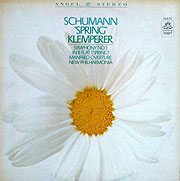 For his first decade of composition, he wrote only for solo piano. Most of those two dozen works were in large-scale forms that eschewed traditional genres (variations, sonatas) for more wide-ranging fantasies. Then, during the year surrounding his marriage, he produced over 150 songs. In ensuing periods, he would turn to chamber music, oratorio and a brief fling at opera, with a smattering of revisited prior genres, although with dwindling inspiration and success. For his first decade of composition, he wrote only for solo piano. Most of those two dozen works were in large-scale forms that eschewed traditional genres (variations, sonatas) for more wide-ranging fantasies. Then, during the year surrounding his marriage, he produced over 150 songs. In ensuing periods, he would turn to chamber music, oratorio and a brief fling at opera, with a smattering of revisited prior genres, although with dwindling inspiration and success.
In 1839, at the end of Robert's decade of solo piano output, Clara wrote in her diary: "It would be best if he composed for orchestra; his imagination cannot find sufficient scope on the piano. … His compositions are all orchestral in feeling. … My wish is that he should compose for orchestra – that is his field! May I succeed in bringing him to it." Schumann himself wrote that he was "tingling to be at work on a symphony. … I believe something will come of it once I am happily married to Clara."
Added impetus toward writing a symphony arose in Franz Schubert's magnificent C-Major Symphony (now known as his Ninth, subtitled the "Great"). Schumann literally discovered the unknown work in a pile of abandoned scores held by Schubert's brother Ferdinand and arranged for the world premiere, which Felix Mendelssohn presented (albeit heavily cut) with his Leipzig Gewandhaus orchestra.
Schumann sketched out his Symphony # 1 in B-Flat, Op. 38 in a mere four days in late January 1841. As he said: "If one is capable of doing anything at all, one must be capable of doing it quickly – the quicker the better, in fact. The flow of one's thoughts and ideas is more natural and authentic than in lengthy deliberation." Indeed, the resulting work, intended to reflect Schumann's longing for Spring (hence its modern subtitle), bursts with zeal and surges forward with constant vitality. But unlike many first efforts that hew closely to accepted formulae, it also presents a novel third movement with two independent trios and a coda built upon fragments of the first.
THE UNIFYING MOTIF IN SCHUMANN'S FOURTH SYMPHONY
The slow, sinuous opening ...

... inverted becomes the Scherzo theme ...

... and suggests the main theme ...

... which accompanies the finale ...
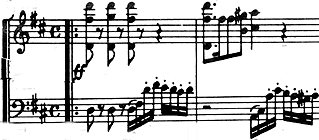
... but has nothing to do with the coda!
 |
Encouraged by its reception at the premiere by Mendelssohn and the Gewandhaus, Schumann quickly produced a second symphony in d-minor that he presented to Clara on her birthday that September. (That same year he also produced a piano fantasy that would become the first movement of his 1845 Piano Concerto, the Overture, Scherzo and Finale and a third symphony, later abandoned.) But its reception was severely disappointing (overshadowed by attention drawn away by a superstar duet by Clara and the mesmerizing Franz Liszt at the same concert), and Schumann set it aside. In succeeding years, he would round out his symphonic output with the somewhat traditional and formal 1845 Symphony # 2 in C Major, Op. 61 and the ceremonial 1850 Symphony # 3 in E flat, Op. 97 (the "Rhenish"). But then, as his final orchestral foray, Schumann returned to the d-minor symphony, and with good reason – it is by far the most innovative and influential of all his works by reason of its extraordinary structure in which all four movements are thoroughly integrated.
Other composers had recalled themes from prior movements in their finales, notably Beethoven in his Fifth and Ninth Symphonies, but each were quoted intact and served as brief respites having no connection with the rest of the finales. Berlioz went further by using a single motif, or idée fixe, which appeared, again unaltered, throughout his Symphonie Fantastique and Harold in Italy in order to depict the journey of a central character. But Schumann progressed further still, by unifying his entire piece with material from a single germinating source. Moreover, unlike with the Beethoven and Berlioz predecessors, his treatment is wholly abstract, without any programmatic purpose or implications. Grove's calls it a landmark in the history of the symphony, and Julius Harrison considers it as interesting to study as it is enjoyable to hear.
As Leonard Bernstein noted, before Schumann a symphony was really a suite of separate movements which complemented each other but could (and occasionally were) played and enjoyed in isolation. Schumann's most palpable means of integrating the four movements of the d-minor symphony was to specify that they be played without pause (he even called the work a "one-movement symphony") and to join the third and fourth movements together with a slow, seething, suspenseful bridge passage (as Beethoven had done with his Fifth). But the unification of the work dwells far deeper within its fabric. It opens with a sinuous motif introduced by the bassoon and second violins that, in both plain and embroidered variants, generates the second "Romanze" movement, its inversion becomes the theme of the third-movement scherzo and a fragment accompanies the main theme of the finale (which itself is both derived from and accompanied by a secondary figure from the opening). Yet, the unity does not stop there, since nearly every theme and accompanying figure throughout the entire work can be traced to elements of that same opening. Although the relationship often is subtle, even unsophisticated listeners can perceive it on a subconscious level. (And just to throw us off balance – and to underscore the tightly integrated nature of the symphony – in the last minute as a final flourish Schumann playfully tosses out a brand new – and for once unrelated – theme and then drops it, leaving it entirely undeveloped, never to be heard again.)
Perhaps recalling the trail-blazing merit of his abandoned d-minor symphony, and perhaps fearing that his creative life was drawing to a close, Schumann revised it for an 1853 music festival at Düsseldorf, where he and Clara would make their final home, albeit briefly. (Published in its final form, it was given the deceptively high opus number of 120; the original version would have been properly numbered as his symphony # 2, with an opus number of around 45.) And that's where the saga of this work becomes interesting, as Schumann's emendations included not only a reworked introduction to the first movement and a new opening to the finale, but significant thickening of the instrumental textures throughout, an "improvement" which scholars and musicians have debated – and largely disparaged – ever since.
 Part of the problem is that Schumann had the misfortune of living in an age in which orchestration had just begun to emerge as a creative force and in which expectations of orchestration as an expressive factor first arose. Just what is orchestration? Groves defines it as "the art of combining the sounds of a large complex of instruments to form a satisfactory blend and balance of tone." Even though this suggests a wide range of subjectivity (just what degree of combination is "satisfactory"?), strict notions of "correct" orchestration were becoming calcified in Schumann's time. Part of the problem is that Schumann had the misfortune of living in an age in which orchestration had just begun to emerge as a creative force and in which expectations of orchestration as an expressive factor first arose. Just what is orchestration? Groves defines it as "the art of combining the sounds of a large complex of instruments to form a satisfactory blend and balance of tone." Even though this suggests a wide range of subjectivity (just what degree of combination is "satisfactory"?), strict notions of "correct" orchestration were becoming calcified in Schumann's time.
A century earlier, orchestration had never been an issue. Bach's music existed independent of any particular instruments. 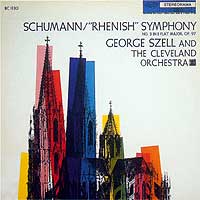 Indeed, many of his works survive in versions for disparate forces, often because Bach himself adapted them to whatever personnel were on hand for a given performance. Indeed, scholars still debate whether Bach's final work, his Art of Fugue, was intended for – or best heard on – harpsichord, organ, string orchestra or wind ensemble. Indeed, many of his works survive in versions for disparate forces, often because Bach himself adapted them to whatever personnel were on hand for a given performance. Indeed, scholars still debate whether Bach's final work, his Art of Fugue, was intended for – or best heard on – harpsichord, organ, string orchestra or wind ensemble.
Orchestration was still not an issue during the classical era (coinciding with the last half of the 18th century), but for a different reason – the constitution of the orchestra became standardized. Thus, Gordon Jacob notes that the classical orchestra was based on strings, with violins carrying most melodies, cellos and basses providing the sonic anchor, violas filling in the harmony, winds mostly sustaining the harmonic background and brass and tympani used for occasional punctuation. Mozart, Haydn and their contemporaries accepted and adhered to this rather rigid scheme, and aside from rare and intentionally novel effects one never reads of their instrumentation, whether in criticism or praise.
By Schumann's time, the winds of change bearing currents of individuality had begun to blow across the orchestral landscape. As traced by Jacob, among Schumann's immediate predecessors, Beethoven raised the status of secondary instruments to treat them independently and individually, Weber used them in picturesque and dramatic ways, and Mendelssohn strove for a clarity of texture. Along with the established expressive elements of dynamics and phrasing, emotional overtones were generated through instrumental coloring. While strings remained essential for the variety of tone and texture they produced, Jacobs notes that the mellow horns became prized for their blending capacity and brass for the powerful support they lent to unison passages. 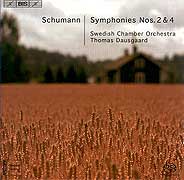 (In part, the emerging role of wind and brass was due to improvements in their design and manufacture. "Natural" horns, in particular, prior to the advent of valves, were limited to the notes of the harmonic series of the specific key in which they were designed to play.) Yet, instead of launching a fascination with individual styles of instrumentation, the new realm of possibilities was again threatened with systemization, as typified by Berlioz's 1844 treatise on orchestration, which exhaustively explored the capabilities of each instrument of the time, both alone and in combination with others, and thus implying a "proper" way to use them. (In part, the emerging role of wind and brass was due to improvements in their design and manufacture. "Natural" horns, in particular, prior to the advent of valves, were limited to the notes of the harmonic series of the specific key in which they were designed to play.) Yet, instead of launching a fascination with individual styles of instrumentation, the new realm of possibilities was again threatened with systemization, as typified by Berlioz's 1844 treatise on orchestration, which exhaustively explored the capabilities of each instrument of the time, both alone and in combination with others, and thus implying a "proper" way to use them.
Schumann's year of prodigious orchestral output fell squarely in the midst of this turbulence. Thus, criticism of the alleged weakness of his orchestration must be placed in this context. The flak often centers on the d-minor symphony for the simple reason that comparisons of the original and revised versions find Schumann competing with himself and so their objective differences provide ample ammunition to denigrate his orchestral outlook.
Both then and since, the consensus is summarized by Carse: Schumann never thought in terms of the orchestra and so his scoring is a matter of conservative routine, much of his material is equally suitable (or not) for various instruments rather than being suited to any in particular, he lacked the instinct to distribute his musical materials in places where they would best contribute to the overall impression, his tone is monotonous and consistently dull, he fails to balance melodic and harmonic elements, and he thickens the lower register with double-stopping (having strings play more than one string at a time) and by doubling the string parts with horns and winds. Harrison adds that Schumann tended to treat the winds (pairs of flutes, oboes, clarinets and bassoons) as a united family whose members rarely venture out on their own, and that his use of four horns, occasionally doubled by trombones, needlessly clutters up the sonic balance.
 Ironically, Schumann provided the proof of such censure in the original version of the d-minor symphony. Among others, his close friend Brahms, who owned the autograph of the original scoring and whose musical judgment few have doubted, vastly preferred it: "It is a real pleasure to see anything so bright and spontaneous expressed with corresponding ease and grace. … Everything is so absolutely natural that you cannot imagine it in any other way – there are no harsh colors, no forced effects. … The score has not gained by being revised. … It has undoubtedly lost much of its charm, lightness of touch and clarity of expression." Brahms suggested that Schumann resorted to the thick orchestration of the revision in order to cover up the ineptness of the Düsseldorf orchestra. A Schumann student, Brian Schlotel, perhaps not wanting to demean his teacher's talent, further claimed that Schumann was not an effective conductor, and so he wanted the work to "play itself." Scholar/conductor Nikolaus Harnoncourt adds that timing itself became a factor: "Schumann wrote with tremendous speed and intensity. … Ironically, Schumann provided the proof of such censure in the original version of the d-minor symphony. Among others, his close friend Brahms, who owned the autograph of the original scoring and whose musical judgment few have doubted, vastly preferred it: "It is a real pleasure to see anything so bright and spontaneous expressed with corresponding ease and grace. … Everything is so absolutely natural that you cannot imagine it in any other way – there are no harsh colors, no forced effects. … The score has not gained by being revised. … It has undoubtedly lost much of its charm, lightness of touch and clarity of expression." Brahms suggested that Schumann resorted to the thick orchestration of the revision in order to cover up the ineptness of the Düsseldorf orchestra. A Schumann student, Brian Schlotel, perhaps not wanting to demean his teacher's talent, further claimed that Schumann was not an effective conductor, and so he wanted the work to "play itself." Scholar/conductor Nikolaus Harnoncourt adds that timing itself became a factor: "Schumann wrote with tremendous speed and intensity. …
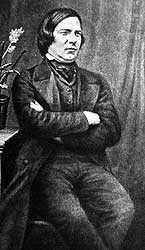
Robert Schumann in 1850 |
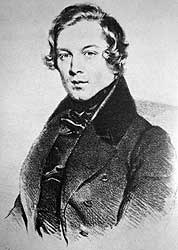
Schumann in 1839 |
At the time when Schumann was writing this symphony … he lived and breathed the ideas involved, ideas inseparable from his biorhythms and from his spontaneous feelings at the time. … He began by sketching on two staves, since he simply couldn't write as fast as he was thinking. In other words, he wanted to capture as much of his ideas as possible and create an architectural structure – a single arching paragraph – over the work as a whole, before sitting down in peace and quiet and elaborating the sketch in the form of a full score." Harnoncourt continues: when Schumann crafted his revision the spontaneity and ideas were no longer there – "he had to approach these things from without" as they "already belonged to the past."
Yet, the later version of the d-minor symphony has its defenders, who make a convincing case for it. Clive Brown rejects the notions that Schumann lacked confidence in the Düsseldorf orchestra or his own leadership skills: "It seems clear that in his late orchestral works he deliberately sought to create a richer, more full-bodied sound to match the earnestness of his musical ideas." (Indeed, one of Schumann's last orchestral compositions was the 1849 Concertstück for Four Horns and Orchestra, which he clearly conceived in order to display a surfeit of the very instruments whose thickening of the texture of the revised d-minor symphony so offended contemporary esthetes.) Jay Harrison compares it to the original version, which he dismisses as "poorly, almost colorlessly orchestrated" and with haphazard voice-leading. He contends: "All of this changed when Schumann revised the work for he had gained enormously in knowledge, experience and the ability to construct a true symphonic edifice." Merton Shatzkin goes further: "Because Schumann put notes in the accompaniment that are the same or very close to melody notes, there tends to be some confusion between the two functions. … It is possible, then, that the composer intended the functions to be ambiguous!" (Emphasis in the original.) Thus, when it came to orchestration perhaps Schumann was not a bumbling incompetent, nor a misguided reviser, as so many would have it, but rather a deeply skilled innovator whose vision evolved throughout his career and who decided that his early symphony merited a heavier garb than he had originally provided. Most music fans must agree, for although both versions of the work have been readily available for quite some time, it is the final version that invariably is played and recorded.
Indeed, it seems fair, if not essential, to relate Schumann's approach toward orchestration to the key role that he played in the Romantic movement. Thus, Hans Fantel views Schumann as the quintessential Romantic composer, as compared to Schubert who harks back to classical structures, Mendelssohn, who was too polite to abandon himself to Romantic expressiveness, and Brahms, whose introspective tendencies already looked forward to the post-Romantic era. Rather, he sees Schumann as giving "unalloyed utterance to that rushing open-handed sweep of fantasy that is the essence of Romanticism – soaring, volatile sentiment moderated by proper manners, emotionality counterbalanced by respect for orderly form."
In that light, here's my take on the controversy: Why should there be "correct" and "faulty" notions of orchestration? Time and again, what one generation's culture condemns as ignorant or sloppy is hailed by another as brilliantly daring and innovative. In his fascinating Lexicon of Musical Invective, Nicolas Slonimsky catalogs hundreds of instances when critics excoriated now-favorite works, including such current examples of musical genius as Beethoven, Chopin, Brahms, Tchaikovsky and Debussy, all of which Slonimsky attributes to non-acceptance of the unfamiliar. So let's assume that Schumann, whose musical talent is lauded in all other aspects, actually liked and sought out the sound of doubled instruments, thick textures, and consistent tone color. For that matter, why should melody always dominate the musical texture? Isn't there something life-like – Romantic! – in a lone melody struggling to be heard over the din of the world and its background? In the notes to his LP of the Schumann d-minor, Bernstein waxes over "the image of Romantic Man, the Artist-God, escaping from the treacherous earth on the aerial currents of a masterpiece." Was Schumann's unusual instrumentation his way of trying to innovate, to rise above the critical blinders and audience conventions of his time, to craft something personal and unique?
 The fact remains that few conductors have seemed content to resist the temptation to "correct" Schumann's "mistakes" of orchestration and accept the d-minor symphony in the form in which Schumann left it. The fact remains that few conductors have seemed content to resist the temptation to "correct" Schumann's "mistakes" of orchestration and accept the d-minor symphony in the form in which Schumann left it. 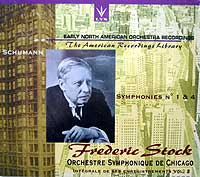 The most radical reworking may have been by Frederic Stock. Program notes for a 1921 Chicago Symphony concert of Schumann's Symphony # 3 indicate that he "found it necessary to add a measure here and there," added contrapuntal embellishment, rewrote the finale (but "employed the master's material"), and added a dozen instruments for a variety of color effects, including a piccolo, English horn, bass tuba, bass drum, cymbals, triangle(!) and a tambourine(!!). (Rather than condemn such arrogance, the January 1, 1922 New York Times reviewed it as "a conscientious and artistic piece of work." Incidentally, that same issue listed New York performances that same week by Coates, Huberman, Strauss, Ney, Gerhardt, Stokowski, Heifetz, Monteux, Casals, Jeritza and Homer – wow!) Stock never recorded his "amplified version" of the Schumann Third, but we do have his 1929 Victor recording of the First and his 1941 Columbia recording of the Fourth, both with the Chicago Symphony (combined on a Lys CD). Neither reflects any extreme adaptation, but rather the "modest, tasteful, regal dignity, devoid of sensationalism" that David Ewin attributes to Stock in his 1943 Dictators of the Baton. While the atypically poor recording of the Fourth obscures much of the tonal balance, his bassoons (reinforced?) consistently stand out from the thick, blurred and largely featureless sonority and there also appears to be a conscious highlighting of melody. All six 78 rpm sides were first takes and fit well together into a uniform flow with moderate inflection and tempo variation, the heavy tone leavened immeasurably by quick pacing (23½ minutes total) culminating in an explosive ending. The most radical reworking may have been by Frederic Stock. Program notes for a 1921 Chicago Symphony concert of Schumann's Symphony # 3 indicate that he "found it necessary to add a measure here and there," added contrapuntal embellishment, rewrote the finale (but "employed the master's material"), and added a dozen instruments for a variety of color effects, including a piccolo, English horn, bass tuba, bass drum, cymbals, triangle(!) and a tambourine(!!). (Rather than condemn such arrogance, the January 1, 1922 New York Times reviewed it as "a conscientious and artistic piece of work." Incidentally, that same issue listed New York performances that same week by Coates, Huberman, Strauss, Ney, Gerhardt, Stokowski, Heifetz, Monteux, Casals, Jeritza and Homer – wow!) Stock never recorded his "amplified version" of the Schumann Third, but we do have his 1929 Victor recording of the First and his 1941 Columbia recording of the Fourth, both with the Chicago Symphony (combined on a Lys CD). Neither reflects any extreme adaptation, but rather the "modest, tasteful, regal dignity, devoid of sensationalism" that David Ewin attributes to Stock in his 1943 Dictators of the Baton. While the atypically poor recording of the Fourth obscures much of the tonal balance, his bassoons (reinforced?) consistently stand out from the thick, blurred and largely featureless sonority and there also appears to be a conscious highlighting of melody. All six 78 rpm sides were first takes and fit well together into a uniform flow with moderate inflection and tempo variation, the heavy tone leavened immeasurably by quick pacing (23½ minutes total) culminating in an explosive ending.
An equally indulgent attitude led George Szell to the other extreme of revision from the Stock Third. 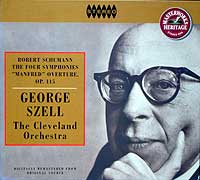 He discredited as a fallacy the notion that Schumann didn't know how to write for the instruments of the orchestra. Rather, he viewed the symphonies as orchestrally conceived and regarded Schumann's imagination of characteristic phrases for the individual instruments to be vivid and accurate. Yet, he considered Schumann's shortcoming to have been an inability to establish proper balances, due to inexperience, which Szell proceeded to remedy by thinning out textures, eliminating doublings, adding or changing notes to clarify themes, rewriting the tympani parts to reinforce the harmony, and generally adjusting dynamics. He stated his goal as "to make the symphonies sound as if Schumann had as much knowledge of orchestration as Weber, but not as much as Richard Strauss" (that is, consistent with the best practices of his time, rather than later evolution). The result is displayed in Szell's lean, bright, crisp, steady and cleanly articulated 1960 Cleveland Symphony recording (Columbia LP, Sony CD), which tends to emphasize the work's classical roots (despite several tempo shifts in the finale). Yet, while lending a refreshing sense of buoyancy, the resulting de-emphasis of any sense of severity or weight seems to present only one side of a more complex conception. He discredited as a fallacy the notion that Schumann didn't know how to write for the instruments of the orchestra. Rather, he viewed the symphonies as orchestrally conceived and regarded Schumann's imagination of characteristic phrases for the individual instruments to be vivid and accurate. Yet, he considered Schumann's shortcoming to have been an inability to establish proper balances, due to inexperience, which Szell proceeded to remedy by thinning out textures, eliminating doublings, adding or changing notes to clarify themes, rewriting the tympani parts to reinforce the harmony, and generally adjusting dynamics. He stated his goal as "to make the symphonies sound as if Schumann had as much knowledge of orchestration as Weber, but not as much as Richard Strauss" (that is, consistent with the best practices of his time, rather than later evolution). The result is displayed in Szell's lean, bright, crisp, steady and cleanly articulated 1960 Cleveland Symphony recording (Columbia LP, Sony CD), which tends to emphasize the work's classical roots (despite several tempo shifts in the finale). Yet, while lending a refreshing sense of buoyancy, the resulting de-emphasis of any sense of severity or weight seems to present only one side of a more complex conception.
Falling somewhere in the middle was perhaps the most famous retoucher of Schumann – Gustav Mahler, who felt that clarity of line was the most important consideration in composing, such that every voice emerged as an independent melody. 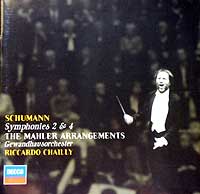 Indeed, his own scores were meticulously notated to ensure this. But he felt that with others' works, the conductor had an obligation: "In order that the music should be played as it was meant to sound, one has to add all sorts of dynamic indications to the parts, so that the principal voice stands out and the accompaniment retires into the background." Mahler also noted that only by the late 1800s were brass instruments able to produce the whole chromatic scale, and that it would seem "almost criminal" not to use them to perform earlier works "as perfectly as possible." (Of course, Szell disagreed, writing that "Mahler adulterates the character of these works by wrapping them in a meretricious garb of sound completely alien to their nature.") As heard in a 2006 recording by Riccardo Chailly and the Gewandhaus Orchestra (Decca CD), most of Mahler's retouchings of the Fourth are more understated than his rhetoric would suggest, and barely distinguishable from the interpretive input of other proactive conductors. Among the 466 changes Mahler made to the Fourth, only a few are apparent and most of those involve dynamics, largely to build more imposing climaxes. As annotator David Matthews notes: "Mahler's restraint is admirable: except in a very few places he does not impose his personality into Schumann's. Rather he acts as a diligent editor." In that context, Matthews makes the cogent observation that "almost all writers have the services of, and benefit from the suggestions of, an editor, yet composers are largely on their own." In that light, perhaps it is unfair to compare the occasional rough edges of Schumann and other performing artists to the presumed polish and refined output of authors (including, of course, Schumann's many published critics). Indeed, his own scores were meticulously notated to ensure this. But he felt that with others' works, the conductor had an obligation: "In order that the music should be played as it was meant to sound, one has to add all sorts of dynamic indications to the parts, so that the principal voice stands out and the accompaniment retires into the background." Mahler also noted that only by the late 1800s were brass instruments able to produce the whole chromatic scale, and that it would seem "almost criminal" not to use them to perform earlier works "as perfectly as possible." (Of course, Szell disagreed, writing that "Mahler adulterates the character of these works by wrapping them in a meretricious garb of sound completely alien to their nature.") As heard in a 2006 recording by Riccardo Chailly and the Gewandhaus Orchestra (Decca CD), most of Mahler's retouchings of the Fourth are more understated than his rhetoric would suggest, and barely distinguishable from the interpretive input of other proactive conductors. Among the 466 changes Mahler made to the Fourth, only a few are apparent and most of those involve dynamics, largely to build more imposing climaxes. As annotator David Matthews notes: "Mahler's restraint is admirable: except in a very few places he does not impose his personality into Schumann's. Rather he acts as a diligent editor." In that context, Matthews makes the cogent observation that "almost all writers have the services of, and benefit from the suggestions of, an editor, yet composers are largely on their own." In that light, perhaps it is unfair to compare the occasional rough edges of Schumann and other performing artists to the presumed polish and refined output of authors (including, of course, Schumann's many published critics).
But others disagreed with the need to depart from the score at all. Charles Gounod found that attitude irreverent and presumptuous: "It is better to leave a great master his imperfections, if he has any, than to impose on him our own." Berlioz, having published the first overview of orchestration, deplored the addition of instruments to old master scores. Igor Stravinsky, one of the greatest orchestrators of all time, insisted that instrumentation is intrinsic to musical ideas, that Beethoven and others found perfect expression in the sobriety of their instrumentation, that the modern taste for opulent sound deforms older music and shows a lack of education.
Two conductors paved the way toward accepting Schumann's unaltered scores through their recordings of the unadulterated Schumann Fourth. Paul Paray and the Detroit Symphony (Mercury, 1954) bristle with energy and match the brisk pace of Stock,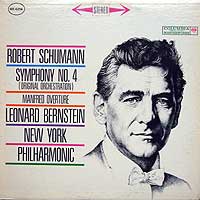 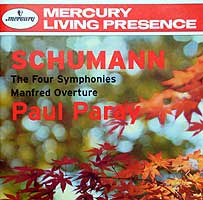 with their sense of onrushing momentum and integration magnified by foregoing any pause between scherzo and trios, as if to underline that they are complementary parts of a continuum (as are the movements themselves). In a highly effective and personal touch, after the slow introduction, Paray launches into the ensuing Lebhaft ("lively") section with recklessly fast speed, only to gradually slow to a "normal" pace as the movement progresses (an effect repeated in the finale), perhaps as a metaphor for the increasing conservatism and diminishing energy as life itself wears on (as reflected in Schumann adding to the magnitude of his Fourth). with their sense of onrushing momentum and integration magnified by foregoing any pause between scherzo and trios, as if to underline that they are complementary parts of a continuum (as are the movements themselves). In a highly effective and personal touch, after the slow introduction, Paray launches into the ensuing Lebhaft ("lively") section with recklessly fast speed, only to gradually slow to a "normal" pace as the movement progresses (an effect repeated in the finale), perhaps as a metaphor for the increasing conservatism and diminishing energy as life itself wears on (as reflected in Schumann adding to the magnitude of his Fourth).
Although Paray's record mentioned use of the unaltered scoring only in its accompanying notes, Leonard Bernstein's 1960 New York Philharmonic LP (Columbia, now Sony CD) boasted it right on the cover. Bernstein's reading fully reflects the composer's youthful ardor, sealed by a bracing finale, taken at a tempo considerably faster than the score's specification of 126 quarter notes per minute, and capped by a delirious ending. His tempo and consistent energy enable the entire repeated section of the finale, for once, to not sound like diffuse filler. Overall, Bernstein's recording deserves all the ample praise it has garnered ever since its release. (Curiously, although Bernstein's notes emphasize the need to play the movements without pause "the better to convey this great Romantic vision of an integrated masterpiece," the original LP ruined the effect by splitting the work over separate sides – needlessly, since the whole performance easily could have fit on one.) His 1985 remake with the Vienna Philharmonic (DG) is slower overall, but compensates with especially ravishing violin accompaniment to the Romanze and a superb seething transition that totters on exaggerated final chords of the scherzo before plunging into the bounding finale, again topped off by a startling surge at the coda.
 This schism, and the performance issues it raises, has led to two major schools of Schumann interpretation. Nearly all of the "Golden Age" conductors agreed with Carse that in order to overcome Schumann's flaws, a valid performance requires at least a tireless readjustment of dynamics and redistribution of parts. In defense of this attitude, it is only fair to note that in Schumann's day performances were relatively rare, and it was expected that the composer would either personally lead his work or be present at others' rehearsals. In either case, he would give verbal input to supplement, or perhaps change, the crude indications of the dry score, which could not possibly notate all the emotion and intent that a composer intended to convey. Thus, a conductor's efforts to breathe life into an old score is not mere impudence, but rather an honest attempt to "read between the lines," as the written notation provides a mere schematic for the sonic translation of the notes into music. This schism, and the performance issues it raises, has led to two major schools of Schumann interpretation. Nearly all of the "Golden Age" conductors agreed with Carse that in order to overcome Schumann's flaws, a valid performance requires at least a tireless readjustment of dynamics and redistribution of parts. In defense of this attitude, it is only fair to note that in Schumann's day performances were relatively rare, and it was expected that the composer would either personally lead his work or be present at others' rehearsals. In either case, he would give verbal input to supplement, or perhaps change, the crude indications of the dry score, which could not possibly notate all the emotion and intent that a composer intended to convey. Thus, a conductor's efforts to breathe life into an old score is not mere impudence, but rather an honest attempt to "read between the lines," as the written notation provides a mere schematic for the sonic translation of the notes into music.
- Hans Pfitzner, "New Symphonic Orchestra Berlin" (Koch CD, 1926; 24½') –
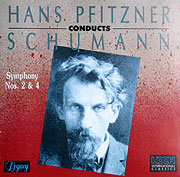 This first extant complete recording of the Fourth is extraordinary, both historically and aesthetically, coming from an unlikely source. Pfitzner (1869 - 1949) clearly was a respected conductor, as he was entrusted with over half of the first German Beethoven symphony cycle, yet his own generally pedestrian compositions and mostly staid, if quirky, Beethoven recordings give little hint of the brilliance of his Schumann, which still astounds with its audacity. Taking his cue from Brahms's observation that the Fourth seems improvisatory, Pfitzner's reading bursts with vitality, surprises and startling contrasts, all of which he manages to seamlessly integrate into a whole organism. (In contrast, the many tempo shifts in his Beethoven "Pastorale" seem arbitrary and rather meaningless in the context of an otherwise stodgy, labored reading.) The growling basses of the opening leap into the allegro, which ultimately evaporates to spawn the delicate second subject after an exquisitely gentle but lengthy pause – a bold and hugely effective transition. An altogether lovely and leisurely romanze leads to a recklessly fast scherzo that sounds in 4/4, each bar seeming to be a single beat (and offset by a "normal" trio section). His finale recalls the opening, with strong but smooth differentiation between the vigorous and lyrical sections. (The Koch CD couples Pfitzner's Fourth with his equally fine and intriguing 1928 Schumann Second with the Berlin State Opera Orchestra.) (Actually, this was a remake of an even more incisive acoustic Polydor set that Pfitzner cut in 1923 with the Berlin Philharmonic but, in an instance of economics trumping esthetics, the scherzo was omitted in order to fit it onto six sides.) Pfitzner's proactive approach paves the way for (and often outstrips) all that would follow. This first extant complete recording of the Fourth is extraordinary, both historically and aesthetically, coming from an unlikely source. Pfitzner (1869 - 1949) clearly was a respected conductor, as he was entrusted with over half of the first German Beethoven symphony cycle, yet his own generally pedestrian compositions and mostly staid, if quirky, Beethoven recordings give little hint of the brilliance of his Schumann, which still astounds with its audacity. Taking his cue from Brahms's observation that the Fourth seems improvisatory, Pfitzner's reading bursts with vitality, surprises and startling contrasts, all of which he manages to seamlessly integrate into a whole organism. (In contrast, the many tempo shifts in his Beethoven "Pastorale" seem arbitrary and rather meaningless in the context of an otherwise stodgy, labored reading.) The growling basses of the opening leap into the allegro, which ultimately evaporates to spawn the delicate second subject after an exquisitely gentle but lengthy pause – a bold and hugely effective transition. An altogether lovely and leisurely romanze leads to a recklessly fast scherzo that sounds in 4/4, each bar seeming to be a single beat (and offset by a "normal" trio section). His finale recalls the opening, with strong but smooth differentiation between the vigorous and lyrical sections. (The Koch CD couples Pfitzner's Fourth with his equally fine and intriguing 1928 Schumann Second with the Berlin State Opera Orchestra.) (Actually, this was a remake of an even more incisive acoustic Polydor set that Pfitzner cut in 1923 with the Berlin Philharmonic but, in an instance of economics trumping esthetics, the scherzo was omitted in order to fit it onto six sides.) Pfitzner's proactive approach paves the way for (and often outstrips) all that would follow.
Among other recordings of the Schumann Fourth, I have found the following to be especially notable or interesting. Note that for the sake of consistency all timings are given as if the first and last movement repeats were not taken, even if they are; at typical tempos, the first adds about 2 minutes and the second about 1½. Also, a word about tempos – Robert Schauffler notes that after Schumann's death his metronome was found to run too fast, thus suggesting that the tempo indications, at least in his late scores, were too slow.
- Dean Dixon, Vienna State Opera Orchestra (Westminster, 1954; 26') – This record is remarkable for a most unfortunate reason,
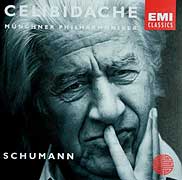 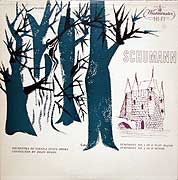 which can barely be inferred from the small, shadowy monotone portrait of the conductor on the back cover – although largely forgotten today, Dixon (1915 – 1976) was one of the very few African American conductors of his time, and seemingly the only one to have achieved even a modicum of success. Born in New York City and urged on by his mother, he studied at Julliard and founded a 70-member orchestra in Harlem while in his teens. But with few opportunities in America, he spent most of his career in Israel, Sweden, Australia and Germany. Propelled by an especially muscular finale, Dixon leads a thoroughly idiomatic and credible reading. which can barely be inferred from the small, shadowy monotone portrait of the conductor on the back cover – although largely forgotten today, Dixon (1915 – 1976) was one of the very few African American conductors of his time, and seemingly the only one to have achieved even a modicum of success. Born in New York City and urged on by his mother, he studied at Julliard and founded a 70-member orchestra in Harlem while in his teens. But with few opportunities in America, he spent most of his career in Israel, Sweden, Australia and Germany. Propelled by an especially muscular finale, Dixon leads a thoroughly idiomatic and credible reading.
- Sergiu Celibidache, Munich Philharmonic (EMI, 1986, 31') – According to the album notes by Cristoforo Sciurrina, Celibidache prized the Schumann Fourth as the essence of symphonic form, as it melded with his Zen outlook of viewing the whole. Thus, his goal was to integrate all its awkward details into a coherent, experiential total picture. Celi dismissed Schumann's tempo and dynamic markings as marginal suggestions for those with no grasp of its essential form, which he felt had to be gleaned from the work's inherent energies. As with most of his late concert work, Celi left us a remarkable and uniquely convincing experience, although hardly an idiomatic one. His patient performance eschews impulse and tension for gradual evolution and mellow abstraction, caressing each phrase and achieving an exquisite balance in which each instrument emerges in its proper turn.
- Wilhelm Furtwängler, Berlin Philharmonic (DG, 1953, 29½') – As recounted by John Ardoin in his Furtwängler Record,
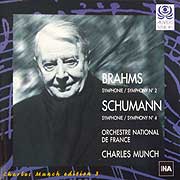 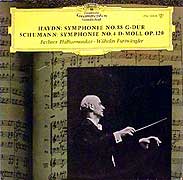 there is good reason why this Furtwängler studio recording is one of the very few that approaches the spontaneity and splendor of his concerts – frustrated over retakes, Furtwängler announced that he would play the work through once more without any breaks and the producer could issue it that way or scrap the entire session. Universally praised (Christopher Howell on the Musicweb International site cites it as "one of the most enthralling recreations of a piece of music ever committed to disc"), Furtwängler's reading seethes with anticipation, its carefully-shaped phrases constantly rising and receding to craft a sense of deep yearning. After a hugely dramatic pause, he leaves us with a deeply satisfying cathartic coda. Otherwise, the pacing is moderate throughout, with only subtle tempo changes to create a continuous flow of sound. Thus, it seems ironic that when critics laud Furtwängler's resultant sense of architecture, they really seem to be praising Schumann himself. there is good reason why this Furtwängler studio recording is one of the very few that approaches the spontaneity and splendor of his concerts – frustrated over retakes, Furtwängler announced that he would play the work through once more without any breaks and the producer could issue it that way or scrap the entire session. Universally praised (Christopher Howell on the Musicweb International site cites it as "one of the most enthralling recreations of a piece of music ever committed to disc"), Furtwängler's reading seethes with anticipation, its carefully-shaped phrases constantly rising and receding to craft a sense of deep yearning. After a hugely dramatic pause, he leaves us with a deeply satisfying cathartic coda. Otherwise, the pacing is moderate throughout, with only subtle tempo changes to create a continuous flow of sound. Thus, it seems ironic that when critics laud Furtwängler's resultant sense of architecture, they really seem to be praising Schumann himself.
- Charles Munch, Orchestre National de France (Valois, 1966; 27') – This most German of readings comes from a most unexpected source – one of the great French conductors (albeit one born and raised in Alsace on the German border). Although Munch left us fleet Beethoven, here he seems to be saying that if critics feel that Schumann's orchestration is too heavy, then let's validate their view and play his music that way. Yet he turns the tables and the result quivers with irony – his weighty phrasing constantly chafes against his airy sonority. Phrase endings linger suspended, the Romanze is cautious and mournful, the transition to the finale is downright scary in its seething mysticism, and the tempo of the finale constantly shifts smoothly between swift and pensive, and then ends on a distended final chord, thus yielding an improvisatory feeling to an otherwise formal and traditional performance. The tepid applause suggests that the audience was baffled at Munch's daring take on a familiar work.
- Hans Knappertsbusch, Dresden Staatskapelle (Music and Arts, 1956, 26¾') – And speaking of truly German readings,
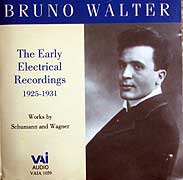 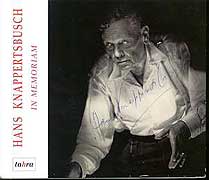 few would doubt Knappertsbusch's credentials on that score. The key feature of this reading is the commanding tympani throughout, announced even before the beginning, when a brief drum roll precedes the opening note. The thundering emphases are altogether fitting to magnify the sonic weight of this dark, grim (yet fairly swift) reading, whose massive layered chords and blaring brass anticipate Bruckner. few would doubt Knappertsbusch's credentials on that score. The key feature of this reading is the commanding tympani throughout, announced even before the beginning, when a brief drum roll precedes the opening note. The thundering emphases are altogether fitting to magnify the sonic weight of this dark, grim (yet fairly swift) reading, whose massive layered chords and blaring brass anticipate Bruckner.
- Bruno Walter, Mozart Festival Orchestra, Paris (VAI, 1928; 23¾') – Excellently played by what may have been a pick-up group and benefiting from a remarkably clear yet full-bodied recording, Walter applies a fine, smooth-flowing interplay of energy and repose to generate a thoroughly convincing image of Romanticism, in which, in Hans Fantel's telling description, searing, volatile sentiment is moderated by respect for orderly form. By contrast, Walter's 1940 NBC Symphony broadcast (AS Disc) is propelled by visceral energy, sharp and precise, with crisp brass and tympani accents, as perhaps would be expected from Toscanini's orchestra. While quite different, as with so many of his other earlier recordings, these superlative renditions remind us how dynamic a conductor Walter was in his prime (that is, before his art was subsumed by the mellow, warm humanism of his final run of Columbia stereo LPs by which he is mostly remembered nowadays).
- Guido Cantelli, NBC Symphony (Music and Arts, 1952; 24') – And if one wonders what Toscanini would have done with the Schumann Fourth (which he rarely performed and never recorded),
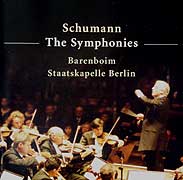 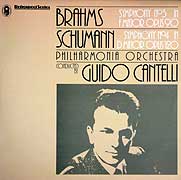 the evidence is decidedly mixed – a slack 1949 broadcast of the Third lacks much of the edgy excitement that he brought to his best performances, while a 1946 broadcast of the Second is surprisingly vital, with an especially fleet scherzo. Cantelli, his protégé and presumed successor, left us a self-assured Fourth with Toscanini's own orchestra (which Toscanini may have helped Cantelli to rehearse) that begins with a firm introduction and goes on to largely reflect the resolute development of his mentor's late NBC Symphony style. In a 1953 studio recording of the Fourth with the Philharmonia (EMI) Cantelli is far more pliant and relaxed (and three minutes slower), thus suggesting that Cantelli's interpretations were in significant part melded to the orchestra he was leading rather than reflecting a distinctive personality of the type that many conductors develop and deploy at a more mature stage in their careers, but which Cantelli, killed in a plane crash at age 36, never had the chance to reach. the evidence is decidedly mixed – a slack 1949 broadcast of the Third lacks much of the edgy excitement that he brought to his best performances, while a 1946 broadcast of the Second is surprisingly vital, with an especially fleet scherzo. Cantelli, his protégé and presumed successor, left us a self-assured Fourth with Toscanini's own orchestra (which Toscanini may have helped Cantelli to rehearse) that begins with a firm introduction and goes on to largely reflect the resolute development of his mentor's late NBC Symphony style. In a 1953 studio recording of the Fourth with the Philharmonia (EMI) Cantelli is far more pliant and relaxed (and three minutes slower), thus suggesting that Cantelli's interpretations were in significant part melded to the orchestra he was leading rather than reflecting a distinctive personality of the type that many conductors develop and deploy at a more mature stage in their careers, but which Cantelli, killed in a plane crash at age 36, never had the chance to reach.
- Daniel Barenboim, Berlin Staatskapelle (Teldec, 2003; 30') – After listening to two dozen other recordings of the Schumann Fourth, I was really ready for Barenboim's bold venture – an unabashed throwback to the 19th century, and perhaps an indication of what his idol Furtwängler might have achieved in concert. Few reviews of his set were neutral – detractors slammed it as mannered and pretentious, while fans lauded it as exhilarating and an altogether fascinating attempt to rediscover a familiar work, in which we never know just what lies around the next corner. Even more brilliant than Barenboim's Fourth is his dazzlingly vibrant Third, into whose formalism he injects astounding emotion.
Other fine recordings of the Schumann Fourth that I can wholeheartedly recommend include those by 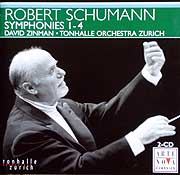 Pierre Monteux and the San Francisco Symphony (RCA LP, 1952), Otto Klemperer and the Philharmonia (EMI, 1960 – but very string-dominated), Herman Abendroth and the Mid-German Radio Orchestra (Music and Arts, 1950, or Leipzig Radio Symphony, Arkadia, 1949 – both with loads of improvised freedom), Gunter Wand and the NDR Orchestra (RCA – heavy and rich but energetic), David Zinman and the Zurich Tonhalle Orchestra (Arte Nova, 2003 – a super-bargain!) and Erich Leinsdorf and the Boston Symphony (RCA, 1963). The Leinsdorf is a rare instance of a conductor tampering with not only the instrumentation but the structure itself – in the Lebhaft section of the first movement he rewrites measures 10 and 11 (which Schumann himself left intact in his revision). Pierre Monteux and the San Francisco Symphony (RCA LP, 1952), Otto Klemperer and the Philharmonia (EMI, 1960 – but very string-dominated), Herman Abendroth and the Mid-German Radio Orchestra (Music and Arts, 1950, or Leipzig Radio Symphony, Arkadia, 1949 – both with loads of improvised freedom), Gunter Wand and the NDR Orchestra (RCA – heavy and rich but energetic), David Zinman and the Zurich Tonhalle Orchestra (Arte Nova, 2003 – a super-bargain!) and Erich Leinsdorf and the Boston Symphony (RCA, 1963). The Leinsdorf is a rare instance of a conductor tampering with not only the instrumentation but the structure itself – in the Lebhaft section of the first movement he rewrites measures 10 and 11 (which Schumann himself left intact in his revision).
And for those familiar with the standard revision of the Schumann Fourth (used in all of the recordings noted above), the original 1841 version provides a fascinating contrast. Superb realizations are available by Nikolaus Harnoncourt and the Chamber Orchestra of Europe (Teldec, 1994), Roy Goodman and the Hanover Band (RCA, 1994) and John Eliot Gardiner and the Orchestre Revolutionnaire et Romantique (Arkiv, 1998). The last two are packaged with the other Schumann symphonies and his Overture, Scherzo and Finale (and the Gardiner, which runs to three discs, also includes the revised version of the Fourth, the Konzertstück for Four Horns and Orchestra, and Schumann's first, aborted orchestral effort, the 1832 "Zwickau" symphony). 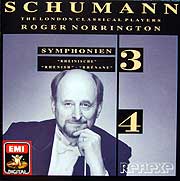 (Despite its good intentions, combining the original score with the seating, bowing, phrasing and articulation of Schumann's era, the bland, anemic, mechanical runthrough by Roger Norrington and the SWR Radio-Sinfonieorchester Stuttgart (Hanssler, 2004) is a huge disappointment – if that's how the audience at the premiere heard the work, no wonder it failed! The frustration is especially keen coming from one of the esteemed pioneers of the historically-informed performance practice movement. Indeed, Norrington had turned in a far more compelling recording of the revised score in 1989 with the London Classical Players (EMI), who display the bracing tempos, rasping brass and softer strings of Schumann's time in what appears to have been the first "authentic instrument" approach to the Fourth even before any recordings of the 1841 version. (Despite its good intentions, combining the original score with the seating, bowing, phrasing and articulation of Schumann's era, the bland, anemic, mechanical runthrough by Roger Norrington and the SWR Radio-Sinfonieorchester Stuttgart (Hanssler, 2004) is a huge disappointment – if that's how the audience at the premiere heard the work, no wonder it failed! The frustration is especially keen coming from one of the esteemed pioneers of the historically-informed performance practice movement. Indeed, Norrington had turned in a far more compelling recording of the revised score in 1989 with the London Classical Players (EMI), who display the bracing tempos, rasping brass and softer strings of Schumann's time in what appears to have been the first "authentic instrument" approach to the Fourth even before any recordings of the 1841 version.
 Much of the background information on Schumann and the history of orchestration is found in the following sources, which I also recommend for further reading, and which also provided the authorities and opinions quoted in this article: Much of the background information on Schumann and the history of orchestration is found in the following sources, which I also recommend for further reading, and which also provided the authorities and opinions quoted in this article:
- Robert Haven Schaufller: Florestan – The Life and Work of Robert Schumann (Henry Holt & Co., 1945)
- Ronald Taylor: Robert Schumann – His Life and Work (Universe Books, 1982)
- The article on Robert Schumann by Gerald Abraham in the 1951 edition of Grove's Dictionary of Music and Musicians
- Julius Harrison's article on Schumann in The Symphony (Penguin, 1966)
- Adam Carse's History of Orchestration (Kegan Paul, Trehch, Trubner & Co., 1925)
- Paul Matthews, ed: Orchestration – An Anthology of Writings (Routledge, 2006)
- The article by Gordon Jacobs on Orchestration in the 1951 edition of Grove's Dictionary of Music and Musicians
- Merton Shatzkin: Writing for the Orchestra (Prentiss-Hall, 1993)
- New York Times January 1, 1922 review: "Music – Rescoring a Masterpiece"
- Clive Brown's notes to the 1989 Norrington EMI CD (7 54025 2)
- Notes to the George Szell CD reissue of his 1960 recording (Sony Heritage MH2K 62319)
- Leonard Bernstein's notes to his 1960 LP (Columbia MS-6256)
- Hans Fantel's notes to the Bernstein LP of the Schumann First (Columbia MS-6581)
- Roy Goodman's notes to his CD box set (RCA 09026-61931-2)
- Joan Chissell's notes to the Haitink LP box set (Phillips 412 852)
- Jay S. Harrison's notes to the Leinsdorf LP (RCA LSC-2701)
- Rainer Cadenbach's notes to the Harnoncourt CD (Teldec 94543)
- David Matthews' notes to the Chailly CD of Mahler's "retouched" editions of the Schumann Second and Fourth (Decca 475 8352)

Copyright 2009 by Peter Gutmann
|
